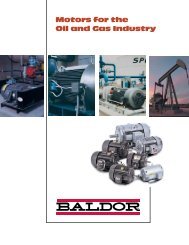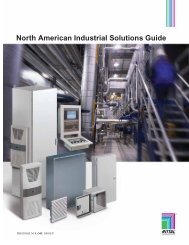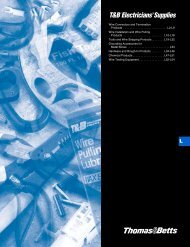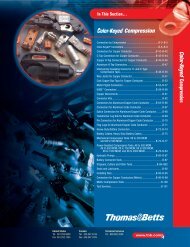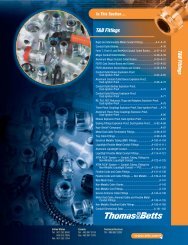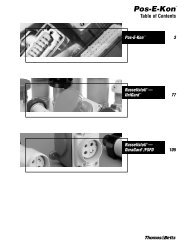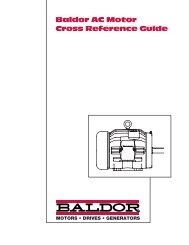Advance 2007 Atlas - Electronic Ballasts Section - SW Electric ...
Advance 2007 Atlas - Electronic Ballasts Section - SW Electric ...
Advance 2007 Atlas - Electronic Ballasts Section - SW Electric ...
Create successful ePaper yourself
Turn your PDF publications into a flip-book with our unique Google optimized e-Paper software.
HIGH FREQUENCY ELECTRONIC BALLASTS<br />
Power Factor (PF) is the measurement of how effectively a<br />
ballast converts the voltage and current supplied by the power<br />
source into watts of usable power delivered to the ballast and lamps.<br />
Perfect power utilization would result in a power factor of one.<br />
Input Watts<br />
PF =<br />
Input Current x Input Voltage<br />
A ballast’s power factor may be classified under any one<br />
of the following categories:<br />
High Power Factor (HPF) 0.90 or greater<br />
Power Factor Corrected (PFC) 0.80 to 0.89<br />
Normal (Low) Power Factor (NPF) 0.79 or less<br />
Power factor measurements pertain only to the effective use of<br />
power supplied to the ballast. They are not an indication of the<br />
ballast’s ability to supply light through the lamps. Because low<br />
power factor ballasts require about twice the current needed by<br />
high power factor ballasts, they allow fewer fixtures per circuit and<br />
create added wiring costs. High power factor ballasts are generally<br />
specified for all commercial lighting applications.<br />
EMI/RFI. Because they operate at high frequency, electronic<br />
ballasts may produce electromagnetic interference (EMI) or radio<br />
frequency interference (RFI). RFI frequencies are a subset of EMI<br />
frequencies. EMI issues cover all possible operating frequencies<br />
while RFI is only concerned with radio and television frequencies.<br />
This interference could affect the operation of sensitive electrical<br />
equipment, such as radios, televisions or medical equipment. All<br />
<strong>Advance</strong> electronic ballasts incorporate features necessary<br />
to afford maximum protection for the operating environment and<br />
operate well within regulatory limits. For more information, see<br />
“The ABC’s of <strong>Electronic</strong> Fluorescent <strong>Ballasts</strong>”.<br />
Ballast Noise. The slight “humming” sound associated with<br />
fluorescent lighting systems results from vibration caused by the<br />
inherent electromagnetic action in the core-and-coil assembly of<br />
the ballasts. All electromagnetic and some electronic ballasts make<br />
this sound. <strong>Ballasts</strong> are assigned a sound rating, “A” through “F”,<br />
based on the amount of sound produced, with “A” being the<br />
quietest. Generally, the larger the lamp and ballast, the higher the<br />
sound level and the sound rating will be. Because electronic<br />
ballasts have smaller components, they have the lowest sound<br />
rating. Some electronic ballasts make almost no sound. There is<br />
no ANSI standard for this rating and it is left up to the manufacturer<br />
to rate their ballasts.<br />
Inrush Current. All electrical devices including ballasts have<br />
an initial current surge that is greater than their steady-state<br />
operating current. A new standard published by the National<br />
<strong>Electric</strong>al Manufacturers Association (NEMA) – NEMA 410 –<br />
Performance Testing for Lighting Controls and Switching Devices<br />
with <strong>Electronic</strong> Fluorescent <strong>Ballasts</strong> – covers worst-case ballast<br />
inrush currents. All circuit breakers and light switches are<br />
designed for inrush currents. The electrical system should be<br />
designed with this issue in mind.<br />
Total Harmonic Distortion (THD). Harmonic distortion occurs<br />
when the wave-shape of current or voltage varies from a pure sine<br />
wave. Except for a simple resistor, all electronic devices, including<br />
electromagnetic and electronic ballasts, contribute to power-line<br />
distortion. For ballasts, THD is generally considered the percent<br />
of harmonic current the ballast adds to the power distribution<br />
system. The ANSI standard for electronic ballasts specifies a<br />
maximum THD of 32%. However, most electric utilities now<br />
require that the THD of electronic ballasts be 20% or less. Almost<br />
all <strong>Advance</strong> electronic ballasts are rated for either less than<br />
20% THD or less than 10% THD.<br />
60 Hz Sine<br />
Wave<br />
Actual Waveform<br />
Third Harmonic<br />
(180Hz)<br />
Non-Dimming Applications<br />
Phase A<br />
Phase B<br />
Low Current<br />
Neutral Wire If low Third Harmonic<br />
on balanced system<br />
Phase C<br />
100% Plus Current<br />
Neutral Wire<br />
(Overheated)<br />
Phase A<br />
Phase B<br />
Third<br />
Harmonic<br />
Phase C<br />
When selecting a ballast for a lighting application, the Total<br />
Harmonic Current (THC) rating of the ballast is more significant<br />
than Total Harmonic Distortion (THD). This is because the absolute<br />
value of harmonic current, not the percentage, affects the electrical<br />
power distribution system. As can been seen in the table on page<br />
1-12, the THC rating of our Standard 2-lamp electronic T8 lamp<br />
ballast is well below that of both the conventional and energysaving<br />
magnetic T12 lamp ballasts it replaces. Moreover, the THC<br />
rating of our Centium electronic ballast is even lower.<br />
Dimming Applications<br />
Mark 7 ® 0-10V and ROVR<br />
Traditional low voltage controlled ballasts and ROVR TM typically<br />
produce less than 10% THD at full light output and less than<br />
20% THD throughout the entire dimming range, but require extra<br />
wires for the control circuit. THC is always lower than that of the<br />
conventional or energy-saving magnetic system.<br />
ELECTRONIC<br />
FLUORESCENT<br />
ADVANCE, 10275 WEST HIGGINS ROAD, ROSEMONT, IL 60018. TEL: (847) 390-5000, FAX: (847) 390-5109 1-11




